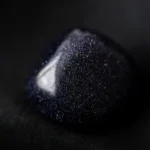Grape agate gemstone is a fascinating gemstone that has been gaining popularity recently due to its unique appearance and metaphysical properties. Known for its beautiful grape-like clusters and calming purple tones, this stone is often used in jewelry and healing practices. Its name derives from its resemblance to bunches of grapes, with small, rounded formations that overlap each other, creating an almost surreal visual effect.
In this comprehensive guide, we will delve into the history, formation, healing properties, uses, and care of grape agate.
Table of Contents
ToggleKey Takeaways:
- Grape Agate is a botryoidal variety of chalcedony, characterized by its distinctive grape-like clusters and stunning purple, lavender, and lilac hues.
- It forms primarily in volcanic regions, with significant deposits found in Indonesia, particularly on the island of Java.
- Grape agate is believed to have metaphysical properties that include promoting calmness, aiding in emotional healing, and supporting spiritual growth and intuition.
- It is commonly used in jewelry and home decor due to its striking appearance, and is also valued in healing practices as a crystal for promoting positive energy.
- Grape agate has a hardness of 7 on the Mohs scale, making it durable for use in various applications, though it still requires gentle care to maintain its beauty.
- Caring for grape agate involves cleaning it with mild soapy water, avoiding harsh chemicals, and storing it safely to prevent scratches or damage from direct sunlight.
What is Grape Agate Gemstone?
Grape agate is a variety of chalcedony, a mineral from the quartz family, which is composed primarily of silica. It is a botryoidal gemstone, meaning that it forms in small, rounded clusters that resemble the shape of grapes. These clusters are usually made up of tiny, spherical crystals that grow together to create the overall structure.
Origin of the Name
The name “grape agate” was coined because of its visual resemblance to grapes, with small, bulbous structures that create the appearance of a cluster. While grape agate is most commonly found in shades of purple, lavender, and lilac, it can also come in various other colors, including white, green, and even some shades of pink.
Where Does Grape Agate Come From?
Grape agate is primarily found in Indonesia, particularly in volcanic regions like the island of Java. The mineral forms in the cavities of volcanic rocks, where it grows over time due to the presence of silica-rich solutions. Its formation process typically involves the deposition of minerals from hot springs, where the mineral-rich water cools and solidifies, resulting in the characteristic botryoidal structure.
Grape agate has become increasingly rare and highly sought after, which has further boosted its popularity among collectors and crystal enthusiasts. As a result, it is important to ensure that the grape agate you purchase is sourced ethically and responsibly.
Physical and Chemical Properties of Grape Agate
Understanding the physical and chemical properties of grape agate can help you appreciate its beauty and uniqueness. As a form of chalcedony, it has several distinct features:
- Composition: Grape agate is composed of silica (SiO2), just like other types of quartz. This makes it a durable stone, resistant to weathering, and suitable for a variety of uses.
- Color: The most common colors of grape agate are purple, lavender, and lilac. However, it can also come in shades of white, pink, and even green. The color is due to the presence of trace elements during the formation process.
- Structure: Grape agate forms in spherical clusters, often in the shape of grapes. This unique structure makes it easily recognizable and highly desirable among collectors.
- Hardness: Grape agate ranks 7 on the Mohs scale of hardness, making it relatively durable but not invulnerable to scratches. It is hard enough for use in jewelry, but care must be taken to avoid damaging it.
- Luster: It has a waxy to vitreous (glassy) luster, which gives it a smooth, glossy appearance when polished.
Healing Properties and Spiritual Significance of Grape Agate
In addition to its beauty, grape agate is believed to have numerous metaphysical properties. These beliefs are deeply rooted in spiritual practices that value crystals and gemstones for their healing abilities. Let’s explore the various spiritual and healing benefits of grape agate:
Calming and Stress Relief
One of the primary benefits of grape agate is its ability to promote relaxation and relieve stress. The calming energy of the stone is thought to soothe the mind and help alleviate anxiety, making it a popular choice for individuals seeking emotional balance and tranquility.
Emotional Healing
Grape agate is also believed to aid in emotional healing. It is said to help those dealing with grief, sadness, or emotional trauma by clearing negative energy and promoting emotional resilience. Many use grape agate during meditation to heal past wounds and restore emotional equilibrium.
Enhancing Intuition and Spiritual Growth
Grape agate is commonly associated with the crown chakra, which is linked to higher consciousness, spiritual insight, and universal connection. Using grape agate during meditation can help enhance intuition, strengthen spiritual growth, and allow for a deeper understanding of one’s place in the universe.
Encouraging Peaceful Relationships
Many people believe that grape agate promotes harmonious relationships by balancing emotions and encouraging empathy and understanding. It is thought to help individuals communicate more effectively and resolve conflicts with compassion.
Enhancing Psychic Abilities
Some practitioners use grape agate to increase their psychic abilities, as the stone is believed to connect the user with spiritual realms and higher levels of consciousness. It is said to facilitate the development of clairvoyance and other forms of intuitive insight.
Grape Agate in Jewelry and Decorative Uses
Grape agate is not only appreciated for its metaphysical properties but also for its striking appearance. Its unique, grape-like clusters make it an ideal material for use in jewelry and home decor.
Jewelry
Grape agate is commonly used to create unique pieces of jewelry, including pendants, earrings, bracelets, and rings. Due to its beautiful, purple hues and eye-catching clusters, it makes for an excellent centerpiece in any piece of jewelry. Whether polished into a smooth cabochon or left in its natural, clustered form, grape agate adds elegance and charm to any accessory.
Home Decor
In addition to its use in jewelry, grape agate is often used in decorative items like sculptures, geodes, and raw stones placed in homes or offices. Its calming color and unusual shape make it an attractive addition to any space, often used as a statement piece or a conversation starter.
Crystal Healing Tools
Grape agate is also commonly used in the form of tumbled stones or crystal grids, which are arranged for healing and spiritual purposes. Many people place grape agate in their homes, meditation spaces, or even under their pillows to promote relaxation and spiritual growth.
Caring for Grape Agate
While grape agate is relatively durable, it still requires some care to maintain its beauty and prevent damage. Here are some tips on how to properly care for your grape agate:
Cleaning
To clean grape agate, use a soft cloth and warm, soapy water. Avoid harsh chemicals or abrasive materials that could scratch or damage the surface. Never use ultrasonic cleaners or steam cleaners, as these can cause fractures in the stone.
Storing
Store your grape agate jewelry and crystals in a safe place, away from other harder gemstones that could scratch them. It is best to keep grape agate in a soft pouch or jewelry box when not in use.
Avoiding Direct Sunlight
Although grape agate is relatively durable, prolonged exposure to direct sunlight may cause its color to fade over time. Keep your gemstone in a cool, dry place, away from harsh light sources to maintain its vibrant color.
Conclusion
Grape agate is more than just a beautiful gemstone—it is a symbol of emotional healing, spiritual growth, and inner peace. With its striking appearance and calming metaphysical properties, it is no wonder that grape agate has become so popular in recent years.
Whether you are drawn to it for its aesthetic qualities or its spiritual benefits, grape agate is a versatile stone that can enhance your life in many ways. By incorporating grape agate into your jewelry collection or using it for healing purposes, you can tap into its powerful energy and embrace its positive influence.
FAQs
What is grape agate?
Grape agate is a type of chalcedony, a mineral from the quartz family, known for its unique, botryoidal (grape-like) structure. It is typically found in shades of purple, lavender, and lilac, and is characterized by its small, rounded clusters resembling grapes.
Where is grape agate found?
Grape agate is primarily found in volcanic regions, with the most significant deposits located in Indonesia, particularly on the island of Java. It forms in the cavities of volcanic rocks where silica-rich solutions cool and solidify.
What are the healing properties of grape agate?
Grape agate is believed to promote emotional healing, reduce stress, and enhance intuition. It is also said to support spiritual growth, encourage peaceful relationships, and aid in meditation practices.
How do I use grape agate for healing?
Grape agate can be used in various ways for healing, such as placing it under your pillow while you sleep, using it during meditation, or wearing it as jewelry. Many people also use it in crystal grids or simply place it in their home to promote positive energy.
Is grape agate durable?
Yes, grape agate ranks 7 on the Mohs scale of hardness, which means it is relatively durable and suitable for use in jewelry and other decorative items. However, it should still be handled with care to avoid scratching or damaging the surface.
I’m Ashaba, a passionate and insightful individual with a deep interest in understanding the human mind, I specialize in exploring the hidden layers of thought and emotion through dream interpretation and storytelling. With a love for unraveling complex ideas, I aim to inspire others through words, offering fresh perspectives on life’s mysteries. Driven by curiosity and creativity, I seek to connect with others, whether through interpreting dreams, crafting narratives, or sharing unique insights into the subconscious mind.






